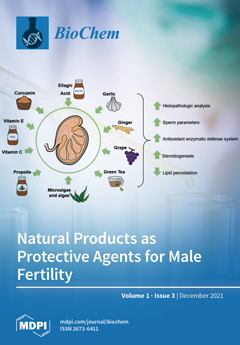BioChem, Volume 1, Issue 3 (December 2021) – 8 articles
The male reproductive system is highly susceptible to noxious influences that can induce germ cell damage and alterations in spermatogenesis, affecting male fertility. Therefore, it is crucial to investigate ways to protect the male reproductive system. Natural products have been used for centuries by humans as therapy, being gradually re-introduced into the pharmaceutical market in recent decades. This review provides an overview of relevant bioactive compounds (curcumin, ellagic acid, vitamin C, and vitamin E) and natural products with bioactive compounds (garlic, ginger, grape, green tea, microalgae and algae, and propolis) that present great potential to protect the male reproductive system. View this paper.
- Issues are regarded as officially published after their release is announced to the table of contents alert mailing list.
- You may sign up for e-mail alerts to receive table of contents of newly released issues.
- PDF is the official format for papers published in both, html and pdf forms. To view the papers in pdf format, click on the "PDF Full-text" link, and use the free Adobe Reader to open them.



